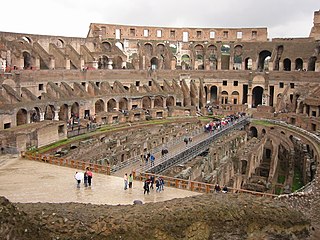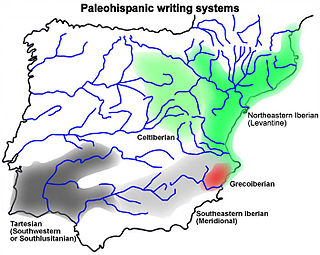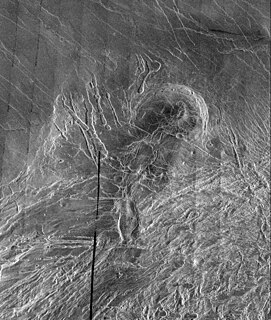
An amphitheatre or amphitheater is an open-air venue used for entertainment, performances, and sports. The term derives from the ancient Greek ἀμφιθέατρον (amphitheatron), from ἀμφί (amphi), meaning "on both sides" or "around" and θέατρον (théātron), meaning "place for viewing".

The Celtiberian script is a Paleohispanic script that was the main writing system of the Celtiberian language, an extinct Continental Celtic language, which was also occasionally written using the Latin alphabet. This script is a direct adaptation of the northeastern Iberian script, the most frequently used of the Iberian scripts.
Hospitium is the ancient Greco-Roman concept of hospitality as a divine right of the guest and a divine duty of the host. Similar or broadly equivalent customs were and are also known in other cultures, though not always by that name. Among the Greeks and Romans, hospitium was of a twofold character: private and public.

The Legion of Mary is an international association of members of the Roman Catholic Church who serve it on a voluntary basis. It was founded in Dublin, as a Roman Catholic Marian Movement by the layman and civil servant Frank Duff.
The Coelerni were an ancient Celtic tribe of Gallaecia in Hispania, part of Calaician or Gallaeci people, living in what was to become the Roman Province of Hispania Citerior, convent of Bracara Augusta, in what is now the southern part of the province of Ourense.
Stirling Energy Systems is a Scottsdale, Arizona-based company which developed equipment for utility-scale renewable energy power plants and distributed electrical generating systems using parabolic dish and stirling engine technology, touted as the highest efficiency solar technology.

Lakshmi Planum is a plateau feature on the surface of Venus on the Western Ishtar Terra. It is named after Lakshmi, the Hindu goddess of wealth.

The Vatican post office has operated its own postal service and issued its own postage stamps since 1929.

A stamp mill is a type of mill machine that crushes material by pounding rather than grinding, either for further processing or for extraction of metallic ores. Breaking material down is a type of unit operation.

Tatworth is a village 2 miles (3 km) south of Chard in the South Somerset district of the county of Somerset, England. It is part of the Tatworth and Forton civil parish and the electoral ward of the same name.

Alpha Regio is a region of the planet Venus extending for about 1500 kilometers centered at 22°S, 5°E.
A tessera is an individual tile in a mosaic.

O! Kypros is the name of a Greek album by singer Anna Vissi released in Greece and Cyprus in 1995. The music featured is traditional Cypriot songs and is a dedication to her parents. A portion of the proceeds from the sale of the album went to help impoverished children in Cyprus. It is Anna Vissi's first release since 1982's Eimai To Simera Kai Eisai To Chthes not to feature Nikos Karvelas either on the composition and lyrics or on the production management.
A tesserarius, was a watch commander in the Roman army. They organized and had command over the nightly guard assigned to keep watch over the fort when in garrison or on campaign and were responsible for getting the watchwords from the commander and seeing that it was kept safe. There was one tesserarius to each centuria. They held a position similar to that of a non-commissioned officer in modern armies and acted as seconds to the optiones.

Roman brick can refer either to a type of brick used in Ancient Roman architecture and spread by the Romans to the lands they conquered; or to a modern type inspired by the ancient prototypes. In both cases, it characteristically has longer and flatter dimensions than those of standard modern bricks.
Xperi Corporation is a San Jose, California-based firm that licenses technology and intellectual property in areas such as mobile computing, communications, memory and data storage, and 3-D Integrated Circuit (“3DIC”) technologies, among others. Markets include semiconductor packaging and interconnect solutions, mobile, computational imaging, audio and automotive. Tessera, a subsidiary of Xperi, has licensed its chip packaging technology to numerous semiconductor manufacturers, including Intel and Samsung Electronics.
DigitalOptics Corporation (DOC) is a San Jose, California-based technology company that designs and manufactures imaging systems for smartphones. DOC’s capabilities include optical design, camera module design and manufacturing, MEMS manufacturing, and image processing algorithms.

Irnini Mons is a volcanic structure on the planet Venus, and is named after the Assyro-Babylonian goddess of cedar-tree mountains. It has a diameter of 475 km (295 mi), a height of 1.75 km (1.09 mi), and is located in Venus' northern hemisphere. More specifically, it is located in the central Eistla Regio region at in the V-20 quadrangle. Sappho Patera, a 225 km (140 mi) diameter wide, caldera-like, depression tops the summit of Irnini Mons. The primary structural features surrounding Irnini Mons are graben, seen as linear depressed sections of rock, radiating from the central magma chamber. Also, concentric, circular ridges and graben outline the Sappho Patera depression at the summit. The volcano is crossed by various rift zones, including the north-south trending Badb Linea rift, the Guor Linea rift extending to the northwest, and the Virtus Linea rift continuing to the southeast.

Tesserae are regions of heavily deformed terrain on Venus, characterized by two or more intersecting tectonic elements, high topography, and subsequent high radar backscatter. Tesserae often represent the oldest material at any given location and are among the most tectonically deformed terrains on Venus's surface. Diverse types of tessera terrain exist. It is not currently clear if this is due to a variety in the interactions of Venus's mantle with regional crustal or lithospheric stresses, or if these diverse terrains represent different locations in the timeline of crustal plateau formation and fall. Multiple models of tessera formation exist and further extensive studies of Venus's surface are necessary to fully understand this complex terrain.

The mapping of Venus refers to the process and results of human description of the geological features of the planet Venus. It involves surface radar images of Venus, construction of geological maps, and the identification of stratigraphic units, volumes of rock with a similar age.

















